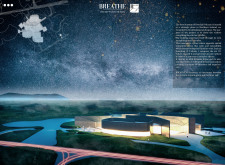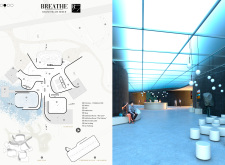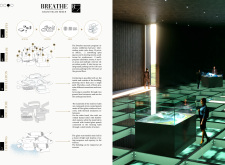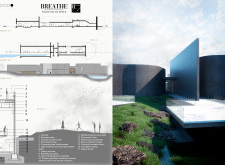5 key facts about this project
The museum consists of various spaces including exhibition halls, multipurpose rooms, a café, and observation points that cater to diverse visitor experiences. Each element plays a crucial role in achieving the primary function of the building: to inform and engage the public about volcanic activity and its implications for the surrounding ecosystem. These spaces are thoughtfully arranged to promote fluidity in visitor movement and interaction with the exhibits.
Integration with Natural Landscape
One of the fundamental aspects that differentiates this project from similar structures is its integration with the natural landscape. The architectural design leverages the unique terrain, utilizing materials that reflect the geological context. The exterior features fiber-reinforced concrete panels, designed for durability against the harsh Icelandic climate, while providing a clean, modern aesthetic that does not overshadow its natural surroundings. The choice of thermal insulation materials contributes to energy efficiency, an essential consideration given the regional weather patterns.
Moreover, the design of the roof employs bubble-deck technology, combining structural integrity with an innovative approach to thermal performance. This method lowers material usage while enhancing the overall sustainability of the structure. The inclusion of frosted glass panels allows natural light to permeate interior spaces, creating a connection between indoors and outdoors, further aligning the architecture with the theme of volcanic energy.
Spatial Dynamics and Visitor Engagement
The Breathe Museum offers an exploratory environment through its varied programmatic elements and circulation routes. Unlike conventional museum designs that often confine visitors to linear pathways, this project encourages a more organic movement throughout the space. The internal circulation routes are designed to facilitate seamless transitions between exhibits, workshops, and observation areas, promoting an immersive experience.
Key features such as the glass floor system showcase geological specimens beneath the visitors' feet, enhancing the educational aspect while also creating visual interest. Observation points strategically placed throughout the museum provide sweeping views of the surrounding volcanic landscape, serving both aesthetic and educational purposes. These vantage points foster engagement with the site and emphasize the symbiotic relationship between the museum and the natural world.
The Breathe Museum exemplifies a thoughtful architectural response to the demands of education, sustainability, and landscape integration. Its innovative use of materials and visitor-centric design sets a benchmark for future projects in similar contexts. For a more comprehensive understanding of the architectural details, including architectural plans and sections, and to explore further architectural ideas, readers are encouraged to review the project presentation for an in-depth examination of this unique facility.


























